
The Book of Esther, also known in Hebrew as "the Scroll", is a book in the third section of the Jewish Tanakh. It is one of the five Scrolls in the Hebrew Bible and later became part of the Christian Old Testament.

Esther is the eponymous heroine of the Book of Esther. In the Achaemenid Empire, the Persian king Ahasuerus seeks a new wife after his queen, Vashti, is deposed for disobeying him. Hadassah, a Jewess who goes by the name of Esther, is chosen to fulfill this role due to her beauty. Ahasuerus' grand vizier, Haman, is offended by Esther's cousin and guardian, Mordecai, due to his refusal to prostrate himself before Haman. Consequently, Haman plots to have all the Jewish subjects of Persia killed, and convinces Ahasuerus to permit him to do so. However, Esther foils the plan by revealing Haman's eradication plans to Ahasuerus, who then has Haman executed and grants permission to the Jews to kill their enemies instead, as royal edicts cannot be revoked under Persian law.
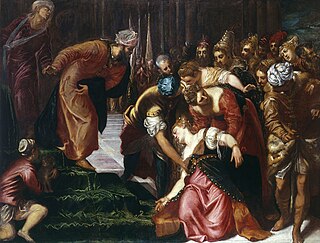
Ahasuerus is a name applied in the Hebrew Bible to three rulers and to a Babylonian official in the Book of Tobit.

Mordecai is one of the main personalities in the Book of Esther in the Hebrew Bible. He is described as being the son of Jair, of the tribe of Benjamin. He was promoted to Vizier after Haman was killed.

Purim is a Jewish holiday which commemorates the saving of the Jewish people from Haman, an official of the Achaemenid Empire who was planning to have all of Persia's Jewish subjects killed, as recounted in the Book of Esther.

Haman is the main antagonist in the Book of Esther, who according to the Hebrew Bible was an official in the court of the Persian empire under King Ahasuerus, commonly identified as Xerxes I but traditionally equated with Artaxerxes I or Artaxerxes II. As his epithet Agagite indicates, Haman was a descendant of Agag, the king of the Amalekites. Some commentators interpret this descent to be symbolic, due to his similar personality.
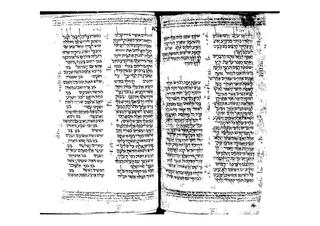
Nehemiah 1 is the first chapter of the Book of Nehemiah in the Old Testament of the Christian Bible, or the 11th chapter of the book of Ezra-Nehemiah in the Hebrew Bible, which treats the book of Ezra and the book of Nehemiah as one book. Jewish tradition states that Ezra is the author of Ezra-Nehemiah as well as the Book of Chronicles, but modern scholars generally accept that a compiler from the 5th century BCE is the final author of these books. This chapter describes Nehemiah's position in the Persian court and his piety.
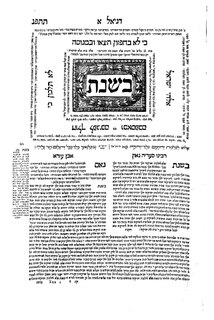
Ezra 4 is the fourth chapter of the Book of Ezra in the Old Testament of the Christian Bible, or the book of Ezra-Nehemiah in the Hebrew Bible, which treats the book of Ezra and book of Nehemiah as one book. Jewish tradition states that Ezra is the author of Ezra-Nehemiah as well as the Book of Chronicles, but modern scholars generally accept that a compiler from the 5th century BCE is the final author of these books. The section comprising chapter 1 to 6 describes the history before the arrival of Ezra in the land of Judah in 468 BCE. This chapter records the opposition of the non-Jews to the re-building of the temple and their correspondence with the kings of Persia which brought a stop to the project until the reign of Darius the Great.

Ezra 6 is the sixth chapter of the Book of Ezra in the Old Testament of the Christian Bible, or the book of Ezra-Nehemiah in the Hebrew Bible, which treats the book of Ezra and book of Nehemiah as one book. Jewish tradition states that Ezra is the author of Ezra-Nehemiah as well as the Book of Chronicles, but modern scholars generally accept that a compiler from the 5th century BCE is the final author of these books. The section comprising chapter 1 to 6 describes the history before the arrival of Ezra in the land of Judah in 468 BCE. This chapter records the response of the Persian court to the report from Tattenai in the previous chapter: a search is made for the original decree by Cyrus the Great and this is confirmed with a new decree from Darius the Great allowing the temple to be built. This chapter closes this first part of the book in a "glorious conclusion with the completion of the new temple and the celebration of Passover" by the people, as their worship life is restored according to the Law of Moses.

Nehemiah 7 is the seventh chapter of the Book of Nehemiah in the Old Testament of the Christian Bible, or the 17th chapter of the book of Ezra-Nehemiah in the Hebrew Bible, which treats the book of Ezra and the book of Nehemiah as one book. Jewish tradition states that Ezra is the author of Ezra-Nehemiah as well as the Book of Chronicles, but modern scholars generally accept that a compiler from the 5th century BCE is the final author of these books. This chapter records the joint appointments of Hanani and Hananiah over Jerusalem and the second appearance of the Golah ("exiles") list, that is, the list of the first returning group of Jews from Babylon, which was documented earlier in Ezra 2 with few variations.

Nehemiah 9 is the ninth chapter of the Book of Nehemiah in the Old Testament of the Christian Bible, or the 19th chapter of the book of Ezra-Nehemiah in the Hebrew Bible, which treats the book of Ezra and the book of Nehemiah as one book. Jewish tradition states that Ezra is the author of Ezra-Nehemiah as well as the Book of Chronicles, but modern scholars generally accept that a compiler from the 5th century BCE is the final author of these books. This chapter and the previous one focus mainly on Ezra; with this chapter recording Ezra's prayer of repentance for the sake of the people.

Esther 1 is the first chapter of the Book of Esther in the Hebrew Bible or the Old Testament of the Christian Bible. The author of the book is unknown and modern scholars have established that the final stage of the Hebrew text would have been formed by the second century BCE. Chapters 1 and 2 form the exposition of the book. This chapter records the royal banquets of the Persian king Ahasuerus until the deposal of queen Vashti.

Esther 2 is the second chapter of the Book of Esther in the Hebrew Bible or the Old Testament of the Christian Bible. The author of the book is unknown and modern scholars have established that the final stage of the Hebrew text would have been formed by the second century BCE. Chapters 1 and 2 form the exposition of the book. This chapter introduces Mordecai and his adoptive daughter, Esther, whose beauty won the approval of the king Ahasuerus, and she was crowned the queen of Persia. Given information from Mordecai, Esther warned the king of an assassination plan, so that the would-be assassins were executed on the gallows, and the king owed Mordecai his life.

Esther 4 is the fourth chapter of the Book of Esther in the Hebrew Bible or the Old Testament of the Christian Bible. The author of the book is unknown and modern scholars have established that the final stage of the Hebrew text would have been formed by the second century BCE. Chapters 3 to 8 contain the nine scenes that form the complication in the book. This chapter describes the reaction of the Jews to Haman's evil decree, focusing on Mordecai's action of mourning and fasting, which eventually forced Esther to take action on her own by risking her life to appear uninvited before King Ahasuerus.
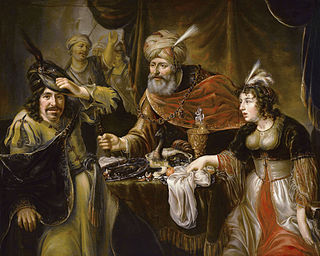
Esther 5 is the fifth chapter of the Book of Esther in the Hebrew Bible or the Old Testament of the Christian Bible, The author of the book is unknown and modern scholars have established that the final stage of the Hebrew text would have been formed by the second century BCE. Chapters 3 to 8 contain the nine scenes that form the complication in the book. This chapter records that Esther's risky behavior to appear uninvited before the king Ahasuerus is richly rewarded, because the king generously offers to give her whatever she wants, 'even to the half of my kingdom' (5:3), but Esther cleverly asks for nothing more than an opportunity to entertain her husband and his chief officer, Haman. Both men were pleased at her hospitality, but when the king again offers her half the empire, this time she requests only a second banquet. While Haman was happy to have been entertained by the queen, he became intensely distressed when Mordecai once more refused to bow down before him. Haman's wife, Zeresh, advised him to erect a monumental gallows intended for Mordecai, and only then Haman felt happy again to look forward to Esther's second banquet.

Esther 6 is the sixth chapter of the Book of Esther in the Hebrew Bible or the Old Testament of the Christian Bible, The author of the book is unknown and modern scholars have established that the final stage of the Hebrew text would have been formed by the second century BCE. Chapters 3 to 8 contain the nine scenes that form the complication in the book. This chapter relates how a sleepless Ahasuerus had his court annals read aloud and discovered that he had failed to reward Mordecai for passing on the information about the assassination plot. The episode leads to 'a marvellously ironic scene', as the narrative 'moves inexorably to its ultimate reversal', starting with Haman leading a king's horse carrying Mordecai, clothed in royal garb through the streets of Susa, and proclaiming the king's favor for Mordecai. Haman went home exhibiting mourning behavior and his wife predicted that Haman's intent to destroy Mordecai would end up with the opposite result.

Esther 7 is the seventh chapter of the Book of Esther in the Hebrew Bible or the Old Testament of the Christian Bible, The author of the book is unknown and modern scholars have established that the final stage of the Hebrew text would have been formed by the second century BCE. Chapters 3 to 8 contain the nine scenes that form the complication in the book. This chapter records the second banquet of Esther. The king Ahasuerus was then determined to grant her any request, so Esther spoke out about the death threat on her people and identifies Haman as the perpetrator of the projected genocide. The king went out to his garden in a rage, but shortly came back to see Haman seemingly threatening Esther on her recliner couch. This caused the king to command the hanging of Haman on the very gallows Haman intended for Mordecai.

Esther 8 is the eighth chapter of the Book of Esther in the Hebrew Bible or the Old Testament of the Christian Bible, The author of the book is unknown and modern scholars have established that the final stage of the Hebrew text would have been formed by the second century BCE. Chapters 3 to 8 contain the nine scenes that form the complication in the book. This chapter contains the effort to deal with the irreversible decree against the Jews now that Haman is dead and Mordecai is elevated to the position of prime minister.

Esther 9 is the ninth chapter of the Book of Esther in the Hebrew Bible or the Old Testament of the Christian Bible, The author of the book is unknown and modern scholars have established that the final stage of the Hebrew text would have been formed by the second century BCE. Chapters 9 to 10 contain the resolution of the stories in the book. This chapter records the events on the thirteenth and fourteenth of Adar and the institution of the Purim festival after the Jews overcome their enemies.
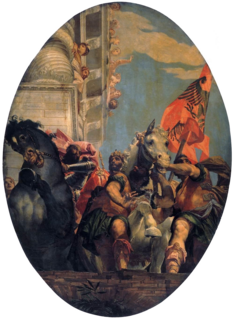
Esther 10 is the tenth chapter of the Book of Esther in the Hebrew Bible or the Old Testament of the Christian Bible, The author of the book is unknown and modern scholars have established that the final stage of the Hebrew text would have been formed by the second century BCE. Chapters 9 to 10 contain the resolution of the stories in the book. This chapter is an encomium to Mordecai, showing his power alongside that of the king, being a Jew as second in command to a Gentile king, serving the interests of both groups—Persians and Jews. It is a picture of an 'ideal diaspora situation' and 'serves as a model for all diaspora communities'.























